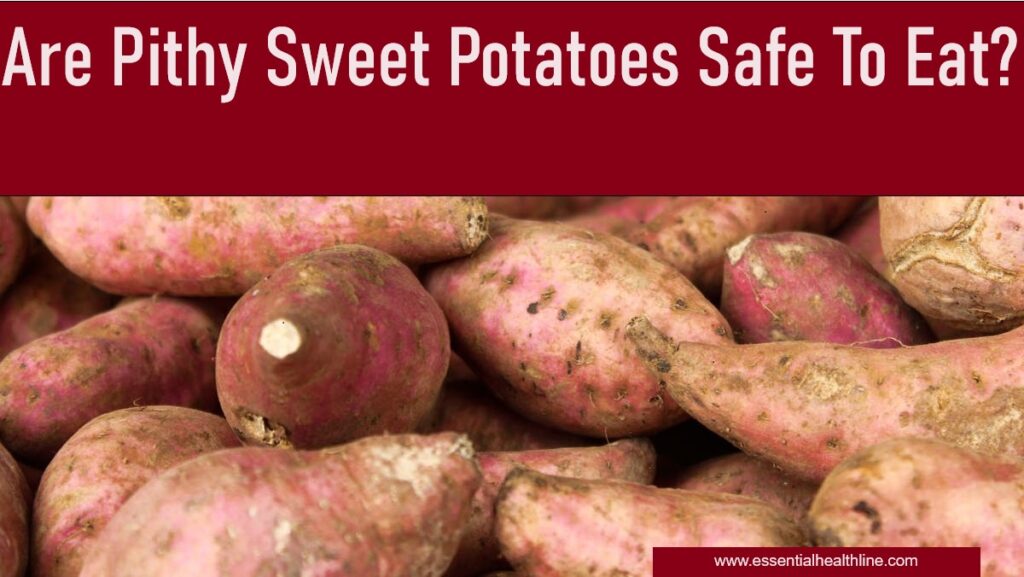Do you know how it feels when you eagerly prepare sweet potatoes only to discover they’re pithy and fibrous? It’s like a culinary letdown. But fear not, we’ve all been there! Now, let’s tackle the burning question: Are pithy sweet potatoes safe to eat?
Indeed! Pithy sweet potatoes might not taste great, but are completely safe for consumption, even though they might not taste great. Ensure they don’t have mold, look rotten, or smell bad. If they do, throwing them away is better to avoid getting sick.
In this article, we’ll delve into the safety of eating pithy sweet potatoes and provide some simple tips to help you enjoy your meal without any worries.
Keep reading!
Are Pithy Sweet Potatoes Safe to Eat?
Indeed! They are safe to eat. The pithiness, which refers to the dry, fibrous texture inside sweet potato, doesn’t pose any health risks.
Factors like how you store them, how old they are, or even the type of sweet potato can make them fibrous.
Store your sweet potatoes in good shape in a dry place like a root cellar or an airtight container.
Regularly check them for signs of spoilage like soft spots, mold, or sprouting. If you see any black spots, cut them out, and the rest of the sweet potato should be fine.
Sweet potatoes have essential nutrients like vitamin C, which helps keep your immune system strong. Eating them is a smart move for your health. Inspect them visually before eating and store them properly to last longer.
Identifying Pithy Sweet Potatoes for Safe Consumption
To identify pithy sweet potatoes, you must look at certain things. Let’s see how you can do that:
- Visual Inspection
- Texture assessment
- Selection of fresh varieties
- Storage conditions
- Consideration of nutritional value
Here’s how.
Visual Inspection
It’s important to carefully check sweet potatoes for signs of being pithy. First, look at the skin color. If it’s bright and even, the sweet potato is probably fresh. But if you see any dark spots or patches, it might be starting to spoil.
Also, watch out for sprouted sweet potatoes or ones oozing white sap. These are signs that they’re old and not good to eat. By paying attention to these details, you can avoid unpleasant surprises when cooking them.
Texture Assessment
Look for soft spots or tiny holes when identifying pithy sweet potatoes. Also, pay attention to the texture and feeling for any sponginess. Examine the skin for discoloration, like black or white spots, which could mean the raw sweet potato is starting to spoil.
Furthermore, inspect for moldy areas or brown spots. Make sure the rest of the sweet potato looks good, too.
Select Fresh Varieties
When picking sweet potatoes, it’s a good idea to choose varieties known to be fresh and tasty. Ask the person at the store or market which types are the best. Look for names like Beauregard, Covington, or Jewel.
While selecting, be mindful of potential health risks associated with texture inconsistencies in certain varieties.
Storage Conditions
When storing pithy sweet potatoes, keep them in a cool, dry place away from sunlight with good airflow to prevent moisture buildup. Watch out for any white substance that could signal mold or spoilage.
Cold temperatures can also help extend their shelf life.
Consider Nutritional Value
Even if sweet potatoes are pithy, their nutritional value remains the same. They’re still packed with vitamins, minerals, and fiber that are good for your health.
These include vitamin A, vitamin C, potassium, and fiber. Eating them before they get too pithy to enjoy all these nutrients is essential.
What Are Pithy Sweet Potatoes?
Pithy sweet potatoes, also known as hollow heart potatoes, can have a weird spongy or stringy inside, unlike regular potatoes. When you slice them, you might find soft or empty parts, affecting how they taste and cook.
This strange texture can happen because they weren’t stored well, damaged, or are too old, mainly when harvested from your vegetable garden.
Even though pithy sweet potatoes aren’t rotten, they might be less tasty or cook unevenly because of their creamy texture.
So, it’s essential to check them carefully before buying. Choose ones that feel firm and don’t have any soft spots or wrinkles.
Even though they might not look or taste perfect, pithy sweet potatoes still have good nutrients that your body needs. So, they’re still a healthy meal choice despite occasionally having a hard center.
Additionally, if you’re considering adding new foods, sweet potato vines can be a great option for adding variety to your diet.
How to Safely Consume Pithy Sweet Potatoes
Here are some easy ways to make pithy sweet potatoes more enjoyable:
- Mash them up: Boil or steam the raw sweet potatoes until soft. Then mash them like you would mashed potatoes.
- Make soup: Blend the cooked sweet potatoes with broth or stock to make a creamy soup.
- Bake them: Use sweet potatoes in recipes like bread, muffins, or pancakes. The other ingredients help make them moist and delicious.
- Put in stews: Add diced sweet potatoes to stews or curries while they cook. The liquid and flavors from the other ingredients make them tasty and soft.
- Roast them: Cut the sweet potatoes into fries or wedges, toss them with oil and spices, and bake them until they’re crispy. It makes a yummy snack.
These ideas can help make your pithy sweet potatoes more enjoyable, even dry ones.
Pithy Sweet Potatoes Health Benefits
Pithy sweet potatoes, often known as sweet potato pith or the central fibrous portion of the sweet potato, offer several health benefits:
- High fiber
- Blood sugar regulation
- Weight management
- Heart health
- Immune support
- Improved brain function
Keep reading as we look into the health benefits of pithy sweet potatoes.
High Fiber
Pithy sweet potatoes are good for you because they’re rich in fiber. Fiber keeps digestion healthy, prevents constipation, and helps manage blood sugar levels, which is especially important if you have diabetes or are at risk.
Eating pithy sweet potatoes can be a tasty and easy way to get more fiber into your diet and keep your body working well.
Blood Sugar Regulation
Pithy sweet potatoes are good for helping control blood sugar levels. They contain lots of fiber, a natural way to slow down how fast sugar gets into your blood. It’s essential, especially for people who want to steady their blood sugar.
Therefore, pithy sweet potatoes are safe to eat, and they can be a tasty and helpful part of managing your blood sugar levels.
Weight Management
Weight management is about balancing what you eat with how active you are. Pithy sweet potatoes can help with this because they’re full of fiber.
Fiber makes you feel full, making you less likely to overeat. Adding pithy sweet potatoes to your meals makes you feel satisfied without overeating.
Moreover, they’re packed with essential nutrients, making them a smart choice for staying healthy while managing weight.
Immune Support
Keeping your immune system strong is vital to staying healthy, and eating pithy sweet potatoes can help. They’re full of nutrients like vitamin C, which helps your immune system fight sickness.
In addition, they also have beta-carotene, which your body turns into vitamin A.
Eating pithy sweet potatoes supports your immune system and keeps you feeling good. So, enjoy these tasty vegetables and give your immune system a boost.
Improved Brain Function
Pithy sweet potatoes boost brainpower with antioxidants like beta-carotene and vitamins C and E, guarding brain cells.
Loaded with choline for memory and fiber for a healthy gut, they improve focus, memory, and how well your brain works.
The Shelf Life of Pithy Sweet Potatoes for Consumption
Pithy sweet potatoes, derived from the sweet potato plant, can last a couple of weeks if stored properly.
Keeping them in a cool, dark place like a pantry in a bag or container extends their shelf life and maintains freshness. This storage method also helps preserve the string roots of the sweet potatoes.
Secondly, check them for any bad spots, like dark or soft areas, which means they’re no longer suitable to eat.
Consuming sweet potatoes relatively soon after purchase helps mitigate the risk of exposure to free radicals, which can compromise their nutritional value.
Proper storage can help them stay yummy and healthy for a long time, so you can enjoy them in your meals without worrying.
Watch out for deep black pits and keep storage temperature below 50 degrees Fahrenheit to prevent spoilage.
Overall, by storing your sweet potatoes properly and checking them regularly for signs of spoilage, you can ensure they remain delicious and nutritious for so long.
Conclusion
Pithy sweet potatoes are safe to eat, especially during harvest season. However, If you spot mold or if the potato looks spoiled, it’s best to throw it away.
Additionally, store sweet potatoes in a cool, dark place to keep them fresh. It’s especially vital for uncooked sweet potatoes. A breathable container can help extend their shelf life and preserve essential nutrients like vitamin C.
So, don’t stress too much. With some care, you can still enjoy your pithy sweet potatoes worry-free.



